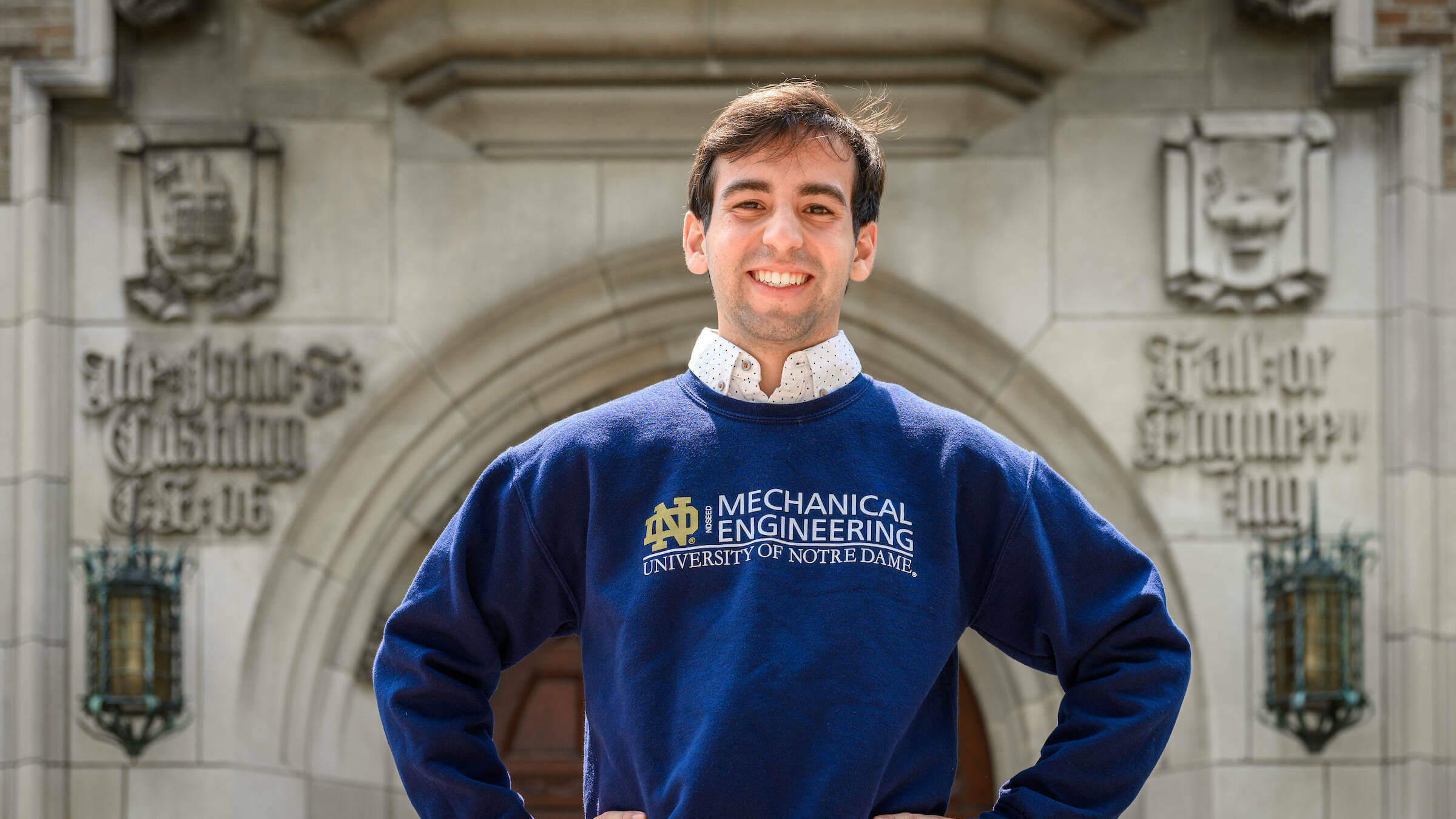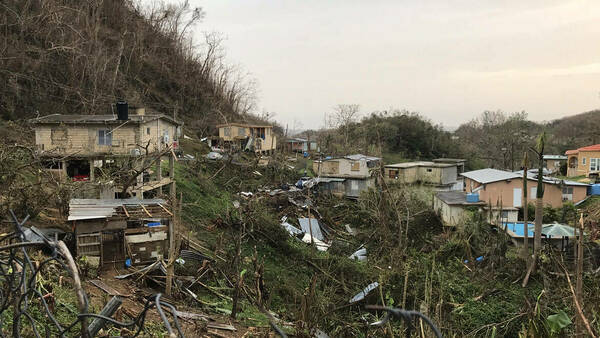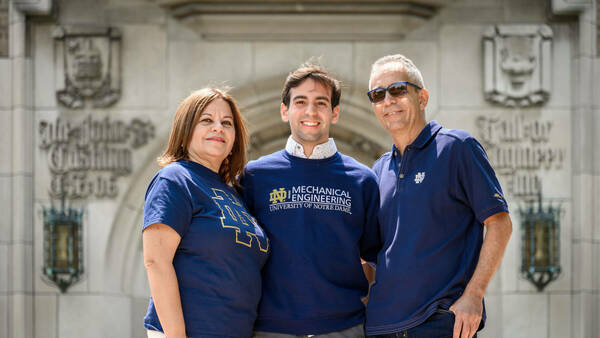Up, up and away
Inspired by the unknown, senior Nelson Badillo Perez reaches for the stars

If all goes to plan, a rocket carrying a payload consisting of a spacecraft, landing module, atmospheric balloon and assorted instruments will launch from Earth and travel some 90 million miles to Venus in 2030, on a mission to explore the planet’s toxic yet, in many ways, remarkably Earth-like atmosphere.
If so, Nelson Badillo Perez, a senior at the University of Notre Dame, will share in the credit.

A mechanical engineering major with a concentration in robotics, the bright, outgoing 21-year-old from the mountains of Puerto Rico spent the summer before his senior year designing, assembling and testing prototypes for the mission — known as the Venus Variable Altitude Aerobot (VVAA) Project — as a research fellow at NASA’s Jet Propulsion Laboratory (JPL) in Pasadena, California.
The Mary E. Galvin Science and Engineering Scholars Program helped fund the fellowship.
“It was the most eye-opening experience,” Badillo Perez said. “The fact that I came from the mountains of Puerto Rico to work with the brightest minds at NASA was mind-blowing to me and a privilege. I got to use the engineering knowledge I gained (at Notre Dame) to make critical design decisions that will shape the future of the Venus program.”
And he’s not done.
The recipient of a highly competitive NASA Space Technology Graduate Research Fellowship, he was recently accepted to Harvard, where he will continue working on the Venus project for the next four to six years as a doctoral candidate in materials science and mechanical engineering.
He credited Notre Dame with giving him the skills but also the confidence to pursue and ultimately achieve such an honor.
“Notre Dame believed in me from day one,” he said. “Notre Dame has made my trajectory possible.”
A novel approach
Named for the Roman god of love and beauty, Venus is unique among the planets in our solar system. Like Earth, it is a rocky planet with ample sunlight. At an altitude of about 40 to 50 kilometers (about 25 to 30 miles), the atmospheric conditions are very similar to Earth’s in terms of temperature and pressure. The planet also has strong atmospheric winds that can carry a balloon or other aerial platform around the planet in a few days.
“When you combine all these things, there’s very high indicators that there might be microbial life (in the atmosphere) that could be the building blocks of life,” Badillo Perez said, making the planet especially ripe for exploration.
The former Soviet Union sent two spacecraft to the planet — Vega 1 and 2 — in 1984, each consisting of a lander and balloon capsule. The balloons orbited at a constant altitude of about 54 kilometers (33 miles), measuring temperature, pressure, wind speed and other metrics within the middle, most active layer of the planet’s three-tiered cloud system.
Nearly four decades later, VVAA represents the next step in balloon-aided planetary exploration: so-called variable-buoyancy balloons that, unlike those associated with Vega 1 and 2, offer access to a large range of altitudes over the course of a flight — and thus increased science return.
“Those Vega missions, they had very little scientific equipment on them, so the amount of information we got from Venus was incredibly valuable but also very limited,” Badillo Perez said. “There’s a lot of things that we still don’t know.”

The Vega missions were also very short: days rather than weeks or months.
“The goal of this new mission is for it to last six months or longer and to traverse a higher range of the Venusian atmosphere,” Badillo Perez said.
In his role at JPL, Badillo Perez was tasked with developing and testing various full- and sub-scale payloads for the mission. He met weekly with project engineers to present his designs and update the project timeline and budget. He also met with parts suppliers and third-party contractors to obtain necessary components for the project.
His work focused largely on the gondola that will hang below the balloon, but the balloon itself is important too. In fact, it’s actually two balloons, one inside of the other.
“It (Hurricane Maria) completely destroyed my entire community. I was completely cut off from home, from school, from, really, the external world for six months.”
“The way it works is we transfer helium from one balloon to another so that we can directly regulate what altitude it is traveling,” Badillo Perez said. “It’s completely novel.”
He presented his work to NASA engineers and fellow interns at the end of the fellowship, and it was included in the proposal sent to NASA headquarters as well. His prototypes were demonstrated for senior NASA officials.
It marked the first time such a high-fidelity prototype, very similar to the one that will travel to Venus, had been created.
From disaster, inspiration
Badillo Perez is from Moca in the mountainous western region of Puerto Rico. He is an only child. His parents own a general store and bakery, which he likens to a C-store or bodega. Growing up, he enjoyed building things and taking them apart. “I was very passionate about Legos,” he said. In 2012, he watched with a mix of awe and excitement as NASA’s Curiosity rover touched down on Mars. The state-of-the-art vehicle would go on to explore the planet for 15 years, far outlasting its original 90-day mission.
“That really opened my eyes,” he said. “I saw the broadcasts about it and just started thinking, ‘How can humans put robots on another planet?’”
Determined to learn, he found a robotics program in the capital, San Juan, and persuaded those in charge of the program to expand it to Moca.
“From there, this passion for robotics really started,” he said. “I got to compete in regional and national competitions, build robots with my team and just learn about engineering.”

In 2017, Hurricane Maria lashed Puerto Rico, destroying buildings and infrastructure and throwing the territory into a prolonged period of economic turmoil. Moca was not spared. Landslides and flooding leveled homes and wiped out roads and bridges. Power was lost for months.
“It completely destroyed my entire community,” Badillo Perez said of the Category 5 storm. “I was completely cut off from home, from school, from, really, the external world for six months.”
He continued, “The only communication channels available were radio, and I would turn on the radio and all I would hear were people calling into the station asking about their family members that were missing. And it turns out that most of them were stuck below rubble in their homes because of mudslides or below floodwaters, and the sad part about it was, there really wasn’t any way to save them — the infrastructure was destroyed, there weren’t enough first responders — and that really shook me.”
“I saw what he was doing and I knew we had someone special. We had nothing to do except to watch him grow, grow, grow.”
It also gave him an idea.
“I remember thinking, ‘What if I can tie in what I learned about robotics and engineering to try to save these people?’ So I started brainstorming about this new first responder robot that can go into collapsed buildings and structures and eventually save these people.”
‘A place for me’
Around the same time, he met José Enrique Fernández.
A 1965 Notre Dame graduate in finance, Fernández grew up in Puerto Rico and worked in the U.S. before returning to the island later in life to establish the Kinesis Foundation, a nonprofit that supports low-income students in pursuit of higher education outside of Puerto Rico. In addition to scholarships, the foundation offers services including personal and career counseling, tutoring, admissions and financial aid assistance and access to technology.
“I told him about my passion for robotics and what I wanted to do and he took me under his wing,” Badillo Perez said of Fernández. “He supported me and he pushed me to apply to Notre Dame. He told me Notre Dame was a place for me, it aligned with my mission. I want to build robots for the good of humanity. I think robots are here to supplement human labor and open new avenues for creating amazing stuff.”
Badillo Perez joined Bright Stars, Kinesis’ college readiness program. Soon, he was recruiting others to the program. Back in Moca, he worked to expand computer access to students in grades 7-12.
“I saw what he was doing and I knew we had someone special,” Fernández said by phone from San Juan, adding, “We had nothing to do except to watch him grow, grow, grow.”
That’s not entirely true.
Among other things, Fernández arranged for Badillo Perez to take the SAT, which is not standard in Puerto Rico. It is also offered only in English. Badillo Perez’s schooling up to that that point had been in Spanish alone.
“It was a big struggle for me, but at the end of it I got it, I got into Notre Dame,” he said. “Notre Dame was actually one of the few places that accepted me.”
The University offered a generous financial aid package, he said, along with access to a wide range of financial, community, campus, club and support services through Multicultural Student Programs and Services, which seeks to nurture a sense belonging, academic success and servant leadership among Notre Dame students of color. He was also accepted to the Galvin Scholars program.
He enrolled in the College of Engineering and later joined the Innovative Robotics and Interactive Systems (IRIS) Lab, where he worked closely with Margaret Coad, assistant professor of aerospace and mechanical engineering, to develop a soft robot that looks like a tardigrade and moves like an amoeba, with potential applications in the public utility and health care fields. The pill-shaped robot can navigate pipes and other small spaces. It can also climb pipes.
“It’s this new type of robot that was inspired by the motion of an amoeba and how an amoeba moves its body by kind of reconfiguring its outer wall. It inverts and turns its body inside out,” Coad said.
She credited Badillo Perez with the mechanical design of the billowy automaton, which uses interior mounted, motor-driven rollers to move back and forth.

“He’s the one who actually built it and did all the hard work to get it to move. He also did experiments to validate the equations that describe how much motor torque you have to exert to get the robot to move, and how to get it to climb up a pipe,” Coad said.
More recently, he’s been prototyping a method to actively steer the robot, she said, so that it can navigate a branching pipe. He’s also been working to scale the robot for medical use.
“One of the applications is scaling it down to a 1-inch diameter for small intestine endoscopy,” Coad said.
Badillo Perez’s work with IRIS culminated in a trip to Japan, where, with Coad along for support, he presented a paper on the extravagantly named “self-propelled soft everting toroidal robot” at the annual International Conference on Intelligent Robots and Systems in Kyoto. The Galvin Scholars program helped fund the trip.
“It was amazing,” Badillo Perez said of the experience. “I got to see the entire robotics community and all of the amazing things that were going on to tackle medicine and disaster response and transportation, and that cemented the idea that I wanted to go to graduate school.”
Long way home
Still, NASA beckoned.
So between lab and classes, he tracked down Issa Nesnas.
A Notre Dame alumnus, Nesnas is a principal technologist in robotics at JPL, where his work focuses on rover development. He was closely involved in the Curiosity mission, the one that so inspired Badillo Perez as a kid. He also was involved in the Perseverance mission, famous for the pioneering Mars helicopter, Ingenuity.
“I found him on LinkedIn and he was really open to talk to me about the work that he was doing at JPL, and I sort of formed a mentor relationship with him,” Badillo Perez said of Nesnas. “And because of him, and with support from the aerospace and mechanical engineering department, I ended up getting the internship at JPL as a robotics visiting researcher.”
“I want to create opportunities for young people to stay in Puerto Rico and to grow and develop the future there,”
From there, it was a hop, skip and a jump, so to speak, to Harvard, where, beginning this fall, he will pursue additional research related to the Venus mission. Specifically, he will work with a NASA engineer and Harvard professor to develop a novel method for collecting rocks and other materials from the Venusian surface, taking advantage of existing mission technology — namely, a conventional air pump.
“The main limitation of the Venus balloon is we can explore the cloud layer — however, while we’re in flight, we really can’t get information, or we can get limited information, from the surface,” Badillo Perez said. “But what if we could greatly extend the capabilities of these aerial platforms by putting highly extendable, soft grippers on them? And what if these soft grippers could use air pressure to extend from mid-air down to the ground and map out the surface and also grab samples and bring them back for investigation?”

Could such technology be used in other areas, such as manufacturing or even disaster response?
That’s the hope, Badillo Perez said.
Beyond graduate school, Badillo Perez plans to continue working with NASA in at least some capacity. That could mean working directly with the agency as an engineer. It could also mean third-party engagement with the agency in the areas of research and development.
Ultimately, though, he wants to return to Puerto Rico and further develop the robotics sector there, both as a way to rebuild the economy and create good-paying and rewarding jobs for young people, many of whom are leaving the beautiful but frequently bedeviled territory for better opportunities elsewhere.
“I want to create opportunities for young people to stay in Puerto Rico and to grow and develop the future there,” Badillo Perez said. “The people of Puerto Rico are incredibly resourceful and incredibly persistent. And because of what they’ve lived through, they are incredible innovators and people who can do a lot of good.”
Latest Commencement
- The Commencement of the class of 2025The University of Notre Dame celebrated its 180th Commencement Ceremony on Sunday (May 18) at Notre Dame Stadium. An audience of some 20,000 graduates, family members, friends and faculty attended, and 2,084 degrees were conferred on undergraduate students, with a total of 3,099 degrees being conferred over the course of Commencement Weekend activities.
- Notre Dame to confer 3,099 degrees over Commencement Weekend, May 17-18The University of Notre Dame’s 180th Commencement Ceremony will take place on Sunday, May 18, in Notre Dame Stadium.
- Clare Cullinan named valedictorian, Bennett Schmitt selected as salutatorian for the Class of 2025Clare Cullinan of South Bend, Indiana, has been named valedictorian and Bennett Schmitt from Jasper, Indiana, has been selected as salutatorian of the 2025 University of Notre Dame graduating class. The 180th University Commencement Ceremony will be held May 18 (Sunday) in Notre Dame Stadium for graduates and guests. During the ceremony, Cullinan will present the valedictory address, and as salutatorian, Schmitt will offer the invocation.
- Notre Dame to confer six honorary degrees at CommencementThe University of Notre Dame will confer honorary degrees on five distinguished leaders in science,…
- Adm. Christopher Grady, Vice Chairman of the Joint Chiefs of Staff, to deliver Notre Dame’s 2025 Commencement addressAdm. Christopher Grady, the Vice Chairman and Acting Chairman of the Joint Chiefs of Staff, will be the principal speaker and receive an honorary degree at the University of Notre Dame’s 180th University Commencement Ceremony on May 18, Notre Dame President Rev. Robert A. Dowd, C.S.C., announced today. Grady, currently serving as the 12th Vice Chairman of the Joint Chiefs of Staff and the nation’s second-highest-ranking military officer, graduated from Notre Dame in 1984 and received his commission through Notre Dame’s Naval Reserve Officers Training Corps.
- The Commencement of the class of 2024The University of Notre Dame welcomed 26,620 graduates, family, friends and faculty to Notre Dame Stadium on Sunday (May 19) to celebrate its 179th Commencement Ceremony. President…













